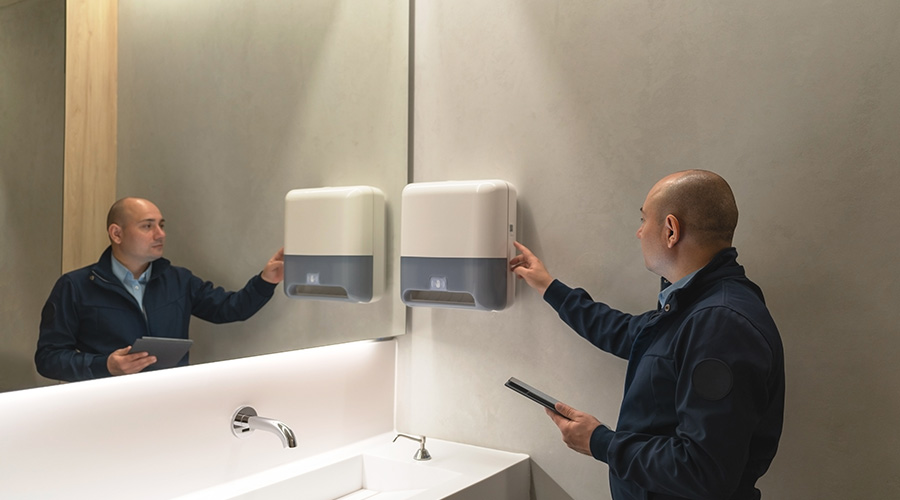 One essential step in specifying the most appropriate drain cleaning equipment is to list all drains by cleanout location, pipe diameter, drain length, type of piping and the type of material likely to be encountered.
One essential step in specifying the most appropriate drain cleaning equipment is to list all drains by cleanout location, pipe diameter, drain length, type of piping and the type of material likely to be encountered.Drain Cleaning: Advances in Tools Expand Power, Versatility
Advances offer managers more opportunities to match equipment options to facility needs.
Drain cleaning technology has come a long way in the last decade as manufacturers expand product lines and enhance existing products to meet customer demands. The changes have meant greater power and versatility for front-line technicians responsible for ensuring drains and piping remain free of clogs to support facility operations.
The challenge for maintenance and engineering managers is to re-familiarize themselves with essential drain-cleaning products, including snakes, water jetters, and sectional machines, in order to specify the most appropriate products based on versatility, cost considerations, and department and facility needs.
Tool improvements
The major improvement related to drain snakes is the increased variety beyond the basic manual 2- to 3-foot trap snakes and toward drill-powered or integral electric corded or cordless models with 100 feet of cable or more. These machines are suitable for a wider range of pipe diameters and types of clogs if fitted with the proper attachments.
In addition to cleaning snakes, technicians can use troubleshooting camera snakes to find and identify the location and type of a clog — clearly an improved method for deciding which cleaning machine to use, the amount of cable, and the attachment best suited to get to the site and clear the clog.
Automatic-feed drum machines are especially effective for medium-range drains from ¾ inch to 2½ inches in diameter up to 50 feet long. Quick-change cables measure ¼ inch or 5/16 inch in diameter for ¾-inch to 1½ inch drains, while technicians can use ⅜-inch cable for 1¼-2½ inch drains. These variable-speed, pistol-grip, and corded or cordless electric machines offer up to 600 rpm, as well as multiple attachments for retracting and push-through, depending on the type of clog, whether it is hair, lint, grease, soap, other semi-solids, or solids.
Water jetters use forward- and rear-facing nozzles. As the water passes through the nozzles, the same volume is restricted so the water velocity substantially increases proportionally to the ratio of inlet hose to nozzle diameter. The water supply does three jobs at once. It propels the jetter through the pipe with less manual effort, it clears the clog, and it cleans the pipe walls.
A water jetter is effective for removing semi-solids from drains by diluting them and flushing to the next cleanout or to the next larger-diameter lateral, where gravity can take over to propel the material to the treatment plant. A low-cost option is a water jetter high-pressure hose, nozzle, and coupling that fits on an existing pressure washer.
Technicians can use sectional machines to clear heavy blockages in larger-diameter drains and sewers. One machine comes with 15-foot cable sections in 1¼-inch diameter cable for 3- to 10-inch diameter drains up to 300 feet long, as well as ⅞-inch diameter cable for 2- 4-inch drains up to 175 feet long.
Cable rotation control in sectional machines tends to be easy. The user pulls the lever, enabling the cable to rotate with 1,500 Watts of power at 600 rpm, and releases the lever to stop the cable. A low machine profile and hard rubber wheels allow easier movement around job sites. One distributor offers a line of more than 30 different sectional and cable drain cleaners for different drain diameters and lengths.
Seeing the problem
With improved color contrast and higher resolution, inline video cameras are rapidly becoming the standard for drain and piping inspection and troubleshooting. Camera components include the camera head and fiber optic cable connected to a PC with a screen, data storage, and WiFi. Users can create reports and send the information off site or back it up instantly.
Thermal imaging also has become a valuable tool for video inspection and detection as the technology’s sensitivity has increased. Pyrometers give only point temperature, while thermal imagers give a heat picture of whole surfaces. Sondes have a role for underground pipe detection, but they do not give as much information about the type of material causing the blockage.
With the addition of report preparation and WiFi, technicians can create and share summary reports. The range of these devices make it possible for technicians to multi-task with one tool. One video inspection system has a range of diameters of 2-12 inches and will reach up to 325 feet. Another new feature is rotational control that keeps the picture displayed right side up.
The thermal condition of piping, fused switches, pumps, and circuit breakers can indicate maintenance issues. Technicians can compare a pre-established baseline temperature profile of a component to its current existing profile, assess the extent of the deterioration, and perform corrective maintenance before costly downtime occurs.
To get the most capability for the budget available, it is important to recognize that drain cleaning machines’ versatility overlaps quite a bit. By understanding this overlap, managers can select products that will help technicians cover every job effectively without wasting a dime.
Related Topics:













